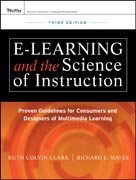
e-Learning and the science of instruction: proven guidelines for consumers and designers of multimedia learning
Clark, Ruth C.
Mayer, Richard E.
ÍNDICE: Acknowledgments. Introduction. 1. e-Learning: Promise and Pitfalls.What Is e-Learning? Is e-Learning Better? The Promise of e-Learning. The Pitfalls of e-Learning. Inform and Perform e-Learning Goals. e-Learning Architectures. What Is Effective e-Courseware? Learning in e-Learning. 2. How Do People Learn from e-Courses. How Do People Learn? How e-Lessons Affect Human Learning. What We Don't Know About Learning. 3. Evidence-Based Practice. What Is Evidence-Based Practice? Three Approaches to Research on Instructional Effectiveness. What to Look for in Experimental Comparisons. How to Interpret No Effect inExperimental Comparisons. How to Interpret Research Statistics. How Can You Identify Relevant Research? What We Don't Know About Evidence-Based Practice. 4. Applying the Multimedia Principle: Use Words and Graphics Rather Than Words Alone. Do Visuals Make a Difference? Multimedia Principle: Include Both Words and Graphics. Some Ways to Use Graphics to Promote Learning. Psychological Reasons for the Multimedia Principle. Evidence for Using Words and Pictures. The Multimedia Principle Works Best for Novices. Should You Change Static Illustrations into Animations? What We Don't Know About Visuals. 5. Applying the Contiguity Principle: Align Words to Corresponding Graphics. Contiguity Principle 1: Place Printed Words Near Corresponding Graphics. Contiguity Principle 2: Synchronize Spoken Words with Corresponding Graphics. Psychological Reasons for the Contiguity Principle. Evidence for Presenting Printed Words Near Corresponding Graphics. Evidence for Presenting Spoken Words at the Same Time as Corresponding Graphics. What We Don't Know About Contiguity. 6. Applying the ModalityPrinciple: Present Words as Audio Narration Rather Than On-Screen Text. Modality Principle: Present Words as Speech Rather Than On-Screen Text. Limitationsto the Modality Principle. Psychological Reasons for the Modality Principle. Evidence for Using Spoken Rather Than Printed Text. When the Modality Principle Applies. What We Don't Know About Modality. 7. Applying the Redundancy Principle: Explain Visuals with Words in Audio OR Text: Not Both. Redundancy Principle 1: Do Not Add On-Screen Text to Narrated Graphics. Psychological Reasons for the Redundancy Principle. Evidence for Omitting Redundant On-Screen Text. Redundancy Principle 2: Consider Adding On-Screen Text to Narration in Special Situations. Psychological Reasons for Exceptions to the Redundancy Principle. Evidence for Including Redundant On-Screen Text. What We Don't Know About Redundancy. 8. Applying the Coherence Principle: Adding Material Can Hurt Learning. Coherence Principle 1: Avoid e-Lessons with Extraneous Audio. Psychological Reasons to Avoid Extraneous Audio in e-Learning. Evidence for Omitting Extraneous Audio. Coherence Principle 2: Avoid e-Lessons with Extraneous Graphics. Psychological Reasons to Avoid Extraneous Graphics in e-Learning. Evidence for Omitting Extraneous Graphics Added for Interest.
- ISBN: 978-0-470-87430-1
- Editorial: John Wiley & Sons
- Encuadernacion: Cartoné
- Páginas: 576
- Fecha Publicación: 27/07/2011
- Nº Volúmenes: 1
- Idioma: Inglés
